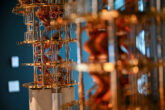September 08, 2025
A Strategic Bet to Advance America’s Quantum Leadership
This article was originally published in Just Security.
The Trump administration has rightly cast securing U.S. quantum leadership as a national security imperative. By harnessing the quirks of subatomic physics, quantum technologies promise vast economic gains in sectors spanning pharmaceuticals, transportation, and communications. They also carry profound security stakes, enabling new battlefield advantages and cyber threats that could rebalance global power. But with tightening federal budgets, advancing America’s quantum ambitions will require smart and creative bets with outsized returns, in the words of Office of Science and Technology Policy Director Michael Kratsios.
Quantum sensing—the most mature quantum technology today—offers just such an opportunity. Targeted federal initiatives could accelerate the deployment of quantum sensors in the next three years. This would unlock substantial defense, security, and economic benefits, while simultaneously strengthening U.S. domestic supply chains and global quantum leadership. Yet timely and decisive action is essential. As Kratsios warned, “There is nothing predestined about technological progress.”
The United States’ lead, however, is increasingly fragile: underinvestment, inconsistent demand, and a brittle supply chain are threatening to trap quantum sensing prototypes in the “Valley of Death.”
Quantum sensors are poised to deliver essential capabilities for defense, critical infrastructure, and commercial sectors, with a market projected to approach $1 billion by 2028. Their most urgent national security application is providing reliable positioning, navigation, and timing (PNT)—the ability to determine locations, plan trajectories, and synchronize activities—when GPS is compromised or unavailable. Adversaries are already jamming and spoofing the weak satellite signals the world relies on, disrupting missions in conflict zones like Ukraine, affecting thousands of commercial flights each day, and even targeting European Commission President Ursula von der Leyen’s aircraft last weekend. Large attacks could trigger systemic defense and critical infrastructure failures costing the United States over $1 billion per day.
By measuring time, acceleration, rotation, and local magnetic and gravity fields with atomic-level precision, quantum sensors provide unprecedented long-term accuracy in positioning and timing without relying on vulnerable external signals. Moreover, unlike other GPS alternatives that use radar, lidar, and cameras, quantum sensors do not emit signals and operate reliably in any weather and environment. These features enable stealthy precision guidance for munitions, submarines, drones, and spacecraft, as well as the stable synchronization of telecom networks, power grids, and financial transactions.
Read the full article in Just Security.
More from CNAS
-
Technology & National Security
Quantum Sensing at Scale: Navigating Commercialization RoadblocksQuantum sensing is racing forward in the lab—but turning prototypes into products still means wrestling with supply chains, certification, and unit economics. In “Quantum Sens...
By Constanza M. Vidal Bustamante
-
Technology & National Security
Atomic AdvantageExecutive Summary One of the most consequential national security contests now unfolds on battlefields invisible to the naked eye—across the faint radiofrequency signals of th...
By Constanza M. Vidal Bustamante
-
Technology & National Security
Accelerate America’s Quantum Technology LeadershipAs the U.S.-China competition for quantum technology leadership continues to intensify, the Trump administration should prioritize both advancing and protecting the country’s ...
By Constanza M. Vidal Bustamante
-
Technology & National Security
The Quest for QubitsThe United Nations General Assembly recently declared 2025 the International Year of Quantum Science and Technology. Quantum information science, a field once exclusive to aca...
By Sam Howell




